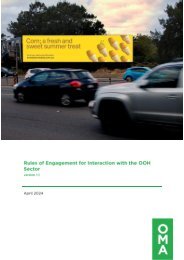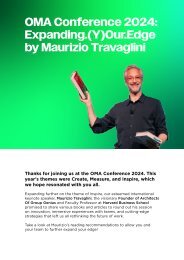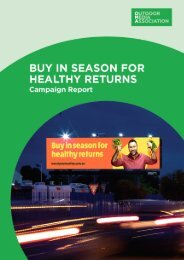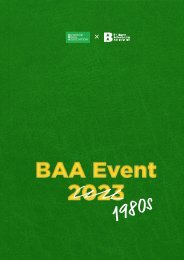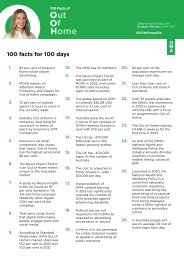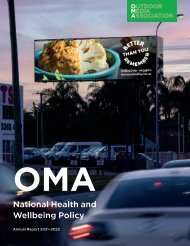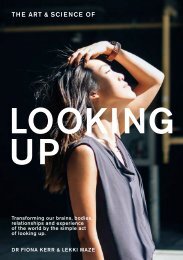OPEN 2
The OPEN series was born from the desire to create a forum for applauding and interrogating strong creative design within the Out of Home (OOH) industry. Illustrating how OOH is part of our cityscape, our commute, our weekend and our shopping and holiday experiences, OOH is ‘the original tweet’ and it cannot be switched off, ignored or fast forwarded. Big, bold, cheeky, simple, clever and controversial, OOH is the ultimate creative stage, allowing brands to be unique, contextually relevant and targeted while reaching mass audiences.
The OPEN series was born from the desire to create a forum for applauding and interrogating strong creative design within the Out of Home (OOH) industry. Illustrating how OOH is part of our cityscape, our commute, our weekend and our shopping and holiday experiences, OOH is ‘the original tweet’ and it cannot be switched off, ignored or fast forwarded. Big, bold, cheeky, simple, clever and controversial, OOH is the ultimate creative stage, allowing brands to be unique, contextually relevant and targeted while reaching mass audiences.
Create successful ePaper yourself
Turn your PDF publications into a flip-book with our unique Google optimized e-Paper software.
INTERACT WITH ME<br />
Leo Roberts, Group Marketing Manager, Integrated<br />
Marketing Communications, Coca-Cola, South Pacific<br />
...<br />
We all know that the world of marketing<br />
communications has changed. Scratch that.<br />
We all know that the world of marketing<br />
communications is constantly changing.<br />
It’s not fixed, it’s dynamic. It’s that dynamism<br />
that inspires us. It’s that dynamism that<br />
infuriates us. Just when we think we know<br />
how to act, we actually need to react. The<br />
pace of change is phenomenal. It’s hard to<br />
fathom. In many ways, it’s overwhelming.<br />
But it’s also very, very exciting.<br />
There are a lot of factors that contribute<br />
to this change, but there is no doubt (in my mind<br />
at least) the greatest single factor influencing<br />
the evolution of marketing communications<br />
today is technological advancement. Not<br />
only have the opportunities for marketers to<br />
connect their brands and ideas with consumers<br />
exploded but also, and perhaps more<br />
importantly, consumers can now choose the<br />
way in which they connect with brands. That’s<br />
the fascinating bit!<br />
Every marketer today knows that<br />
consumers are no longer powerless recipients<br />
of our messages. We know that they can easily<br />
shun our advances if they so choose. While<br />
this is important to note, the more important<br />
fact is that it is just that, a choice, and it does<br />
not necessarily have to be the outcome. Yes,<br />
consumers can now time-shift their way to<br />
a commercial free Utopia (I know I often do)<br />
but, at the same time, technology has opened up<br />
a myriad opportunities. It allows us to partner<br />
with consumers. It facilitates and encourages<br />
participation in our brands and ideas and,<br />
ultimately, it enables us to harness them as<br />
distribution partners.<br />
So what are some good examples?<br />
The fact is there are quite a few but<br />
I’ve selected three of the most recent and<br />
my personal favourites.<br />
The first, New Zealand’s Powerade<br />
challenge, has technology absolutely at its heart,<br />
in this case, Radio-Frequency Identification<br />
(RFID). The campaign was specifically<br />
designed to encourage consumer interaction,<br />
with the ultimate aim of integrating Powerade<br />
into the training regimes of our consumer<br />
target. We designed a fully interactive outdoor<br />
fitness course along the Auckland foreshore<br />
where people could train. Large-format<br />
billboards were then placed along the course<br />
that, using RFID, communicated personalised<br />
messages of support to each individual. The<br />
results spoke for themselves and are probably<br />
best evidenced by the fact that the Powerade<br />
challenge is now in its fourth year and consumer<br />
participation continues to grow.<br />
Another example is from Fanta. Given<br />
we wanted to reach teens, we knew that our<br />
communications absolutely needed to be fun,<br />
participatory and interactive. Technology was<br />
again at the heart of this campaign, in this<br />
case a mobile application. Along with a series<br />
of games, the application was designed to<br />
allow consumers to interact with the outdoor<br />
elements of the campaign. The introduction<br />
of image recognition technology made the<br />
Fanta characters appear to jump from the<br />
outdoor panels and be caught within the<br />
application. The result was that, instead of just<br />
communicating at teens, we used technological<br />
innovation to encourage them to lean into the<br />
campaign, to actively choose to participate and<br />
to have fun with the brand and its idea.<br />
The final example is Coca-Cola’s 2011<br />
Share a Coke campaign. For this, we took our<br />
iconic Kings Cross outdoor site and, through<br />
the application of different technologies,<br />
used it to launch the campaign in a truly<br />
participatory way. For three nights, consumers<br />
were able to text their name, or the names<br />
of their loved ones, and see them ‘magically’<br />
appear on the iconic billboard. Through<br />
155 /



